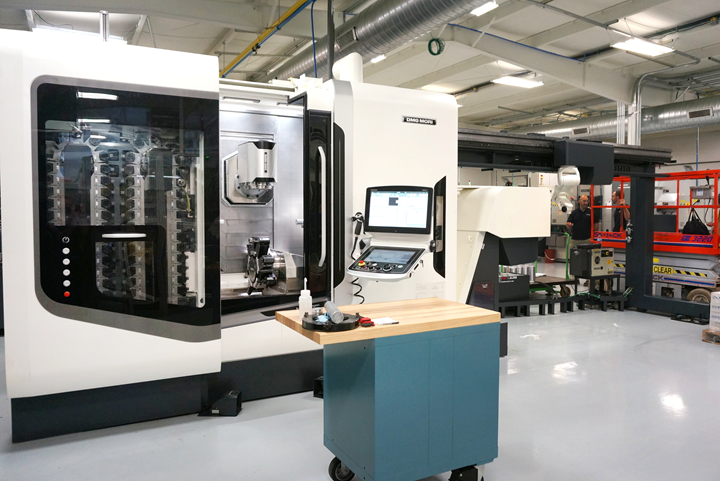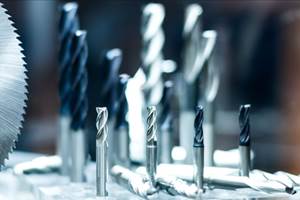Modern Machine Shops Must Invest in Technology and Training
Investing in new technology, training and automation is a necessity for keeping up with the changing nature of manufacturing, according to Tony Staub, founder of Staub Precision Machine Inc.
Share








ECi Software Solutions, Inc.
Featured Content
View More
Autodesk, Inc.
Featured Content
View More
.png;maxWidth=45)
DMG MORI - Cincinnati
Featured Content
View More
Takumi USA
Featured Content
View MoreInvestment in new technology and automation is a cornerstone of Staub Precision Machine. One recent addition is this new mill-turn machine: A DMG-MORI NTX1000 with built-in gantry robot. Photo Credit: Staub Precision Machine Inc.
The world is changing all around us. Manufacturing is not only changing in my town, it’s changing in our country and it’s changing in the world. What determines which shops are successful as the tides turn?
One factor to consider is a shop’s investment in new technology, new capabilities and personnel training. How a shop invests in technology for the future indicates whether it can stay current and respond to change. In our opinion, aggressive investment in new technology has been one of the biggest reasons for Staub’s success.
For years, we at Staub have made it a goal to reinvest 20 percent of gross sales right back into the business in the form of equipment and technology. Some years, we exceed that, and others we are shy, but we remain convinced that investment is vital to our survival. We are continually looking to add technology and capabilities. I’d like to share some ways that our company is investing.
We recently decided to invest in a turret lathe to add capacity for a particular bar-size range. This purchase could have been straightforward — a machine with the standard footprint and capabilities, simply newer, faster and more accurate than other similar equipment that we have. Instead of just buying the direct replacement, we also purchased a large FANUC robot and designed and built an automated chucking production cell to get better throughput on jobs that can’t utilize the standard barfeeder.
Two years ago, we purchased our second new five-axis machining center. It has linear motors and a high rpm HSK spindle — a very advanced machine tool. On this machine, we added a German-built, robot-like parts and pallet loading/unloading system with auto-actuated vises. Our vision is to run this machine unattended for up to 15 hours per day with no operator in the building!
This year, we’ve added an integrated mill-turn center. This machine has two turning spindles, a bar feeder, a lower turret and a swiveling milling spindle with tool changer. The machine spindle utilizes Capto tooling. Attached is a robot suspended from a beam. It can be used as a loader, an unloader or a post-processor. We’ll be able to wash or mark parts or deburr as part of the process. Crucially, this machine also comes with the latest software and technology available!
Nearly every new machine that we purchase has some level of automation. Many times, we have integrated robots to load and/or unload work pieces. There are numerous benefits to automation, as we all know — the most direct benefit is that we can gain unattended runtime and extend our production window. If we aren’t pushing these barriers, we cannot be competitive in today’s market. Investment in and adoption of automation is no longer a choice.
It hasn’t just been our machining operations that have seen investment. We have invested in a full-service enterprise resource planning (ERP) system to tie together our machine tools, inventory, purchasing, accounting and production processes. In our quality department, multi-sensor inspection equipment and hands-off measurement systems give us accurate information and allow us to store our data for analysis.
Our staff has increased to 36 full-time employees. They are competitively paid and we provide health insurance and a generous 401K matching plan. We have been hiring personnel to serve our current needs, but also to build a base for the future. We regularly offer training at little or no cost to the employee.
The investment in new technology pays off in more than just machine uptime. New technology challenges our employees to learn and grow. It gives them late-model, high-end equipment to work with. It gives us the capabilities to go after new opportunities and speak with new customers. Staying in touch with new technology and advancements in our industry helps — forces? — us to think outside of the box and keep up with advancements in manufacturing. Doing things the way we’ve always done them just doesn’t make sense when you’re aware of what is out there.
If you’ve read this article thus far: These examples from Staub add up to make a point. Investment is not a choice, it is a necessity. We are not the best shop in the world, but we are far from the bottom. We do not take all the money out of the business — we believe in sustainability.
Over the years, we have invested in some exciting equipment and some of the latest concepts in the machining world. We are able to gain many hours of production without direct labor. We are more competitive with our overseas competition, as well as the shops in our area. We are certainly concerned about the present, but we are investing for the future. In fact, we’re bullish on the future of Staub!
We believe in efficiency, technology and continuous improvement, and our investments reflect that. We also believe in sharing our business philosophy with other shops. We are excited to see the commitment from others to further the improvement and growth of our industry.
About the Author
Tony Staub
Tony Staub founded the company in his family garage in 1975. Today, Staub Precision employs 35 people and uses automation and leading-edge technology to produce complex machined components for industries including aerospace, medical and communication.
Related Content
Addressing the Manufacturing Labor Shortage Needs to Start Here
Student-run businesses focused on technical training for the trades are taking root across the U.S. Can we — should we — leverage their regional successes into a nationwide platform?
Read MoreHow I Made It: Amy Skrzypczak, CNC Machinist, Westminster Tool
At just 28 years old, Amy Skrzypczak is already logging her ninth year as a CNC machinist. While during high school Skrzypczak may not have guessed that she’d soon be running an electrical discharge machining (EDM) department, after attending her local community college she found a home among the “misfits” at Westminster Tool. Today, she oversees the company’s wire EDM operations and feels grateful to have avoided more well-worn career paths.
Read MoreFinding the Right Tools for a Turning Shop
Xcelicut is a startup shop that has grown thanks to the right machines, cutting tools, grants and other resources.
Read MoreFinding Skilled Labor Through Partnerships and Benefits
To combat the skilled labor shortage, this Top Shops honoree turned to partnerships and unique benefits to attract talented workers.
Read MoreRead Next
Smart Shops Will Continue to Invest in New Technology
Although our latest survey shows that spending on machine tools will slow in 2016, it’s an “investor’s market” for metalworking companies with vision and boldness.
Read More5 Rules of Thumb for Buying CNC Machine Tools
Use these tips to carefully plan your machine tool purchases and to avoid regretting your decision later.
Read MoreRegistration Now Open for the Precision Machining Technology Show (PMTS) 2025
The precision machining industry’s premier event returns to Cleveland, OH, April 1-3.
Read More












.png;maxWidth=150)





















.jpg;maxWidth=300;quality=90)







